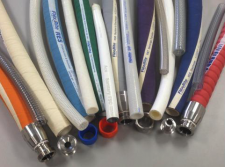How to Select the Right Sanitary Hoses for Your Plant
Choosing the right sanitary processing equipment is not a task that should be taken lightly. Likewise, selecting the right hoses for your sanitary processing operation is critical to maintaining a facility that meets FDA and other agencies’ regulations. Plant managers who oversee the processing of food, drug and other consumables must select hoses and equipment that adhere to minimum sanitary design standards in order to guarantee a safe and efficient operation.
SANITARY HOSE APPLICATIONS
 Sanitary hoses play a critical role in sanitary processing. A hose is a flexible connector used to transfer product from point A to point B in a variety of sanitary segments, including dairy, food, beverage, personal care, pharmaceutical and bio-pharm processing. Sanitary hoses come in a variety of construction materials including rubber, teflon, PVC, and silicone. Your process application will determine the options you require.
Sanitary hoses play a critical role in sanitary processing. A hose is a flexible connector used to transfer product from point A to point B in a variety of sanitary segments, including dairy, food, beverage, personal care, pharmaceutical and bio-pharm processing. Sanitary hoses come in a variety of construction materials including rubber, teflon, PVC, and silicone. Your process application will determine the options you require.
Selecting the Right Sanitary Hose
Selecting the right hose for the job requires careful examination, and managers must determine which hose type will be appropriate for their specific needs. Important considerations include hose construction and coupling styles. Plant managers must also evaluate hose performance metrics that include working pressure, minimum bend radius, vacuum and discharge, and bacteria resistance. Smooth handling, bounce back design, and temperature resistance also have a role in the selection process.
The STAMPED Evaluation Technique
Not all hoses are constructed in the same way and with the same components, so we recommend using a S.T.A.M.P.E.D. analysis process when selecting a sanitary hose solution.
S – size of hose, specifically inside diameter
T – temperature resistance for both product transfer and cleaning
A – application; what will the hose be used for and how, where, and when will it be used
M – the media that will be transferred
P – pressure for both product transfer and cleaning
E – end connectors, including the type and alignment with standard sanitation equipment couplings
D – delivery status; how quickly can the hose be deployed and any special packing requirements
At Rodem, we not only distribute a variety of food processing sanitation solutions from some of the top manufacturers in the industry but we also support those solutions with in-house engineers who can custom design, implement, and repair your equipment. Ask one of our sanitary process experts about our services, which include safety visits, equipment audits, and other services.


